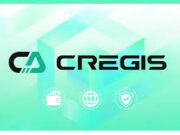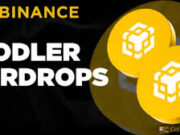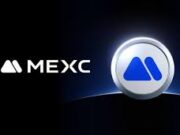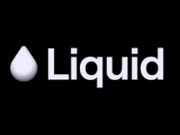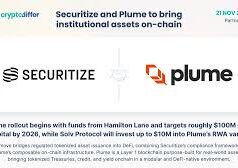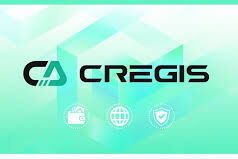If you’d told me five years ago I’d be poring over tokenized treasuries and automated yield strategies, I’d’ve laughed you off. Back then, crypto was memes and moonshots—not this mature beast. Fast forward to September 2025, and the stats speak for themselves: onchain asset management—smart contract-driven portfolios, blockchain credit protocols, tokenized strategies—has surged 118% year-to-date, reaching $35 billion in assets under management (AUM). According to Keyrock’s latest report, that number could nearly double again by 2026. (Keyrock)
This isn’t wishful thinking—it’s empirical data. In collaboration with Maple Finance, Keyrock provides a deep dive into how capital is being reallocated onchain, why institutional adoption is accelerating, and what risks lie ahead. Let’s unpack what this explosion means, why it’s happening now, and whether your portfolio should be part of it.
What Is Onchain Asset Management?
To start, “onchain asset management” isn’t just HODLing crypto. Instead, it means deploying capital directly on blockchains (Ethereum, Solana, Base, etc.) through smart contracts that automate allocation, optimize yields, and tokenize exposures—all without intermediaries.
Keyrock’s report breaks this landscape into four core categories:
- Automated yield strategies (vaults, yield aggregators)
- Discretionary strategies (active onchain portfolio management)
- Onchain credit (lending and underwriting against tokenized real-world assets)
- Structured products (derivative-like instruments built onchain) (Keyrock)
At the start of 2025, total AUM across these strategies was about $16.5B. Now it’s crossed $35B—a 118% increase. (Keyrock)
- Automated yield remains the “gateway” product with ~$17–$18B AUM as of mid-2025, enabling users to deposit stablecoins and let algorithms chase yield across protocols. (The Defiant)
- Discretionary strategies have exploded: up 738% YTD as quant funds and active allocators deploy real-time signal models onchain. (Keyrock)
- Credit and structured products round out the picture, enabling lending against tokenized assets and yield derivatives that combine composability + transparency. (Keyrock)
Because these strategies are composable, institutions can “stack” yield modules, credit exposures, and hedges—something TradFi doesn’t permit. That architecture is becoming the backbone for the next generation of capital markets.
Why Institutions Are Flooding In
So why now? Why has 2025 become the breakout year?
First, regulatory clarity is improving. In Europe, MiCA (Markets in Crypto-Assets Regulation) is creating uniform rules for crypto asset services, disclosures, and authorization. (ESMA) Similarly, policies like the U.S. GENIUS Act (in development) are further reducing uncertainty around digital assets.
Second, institutional sentiment has shifted. A January 2025 Coinbase-EY survey revealed that 85% of institutional investors either hold or plan to hold digital assets by year-end. (CoinDesk) Meanwhile, digital asset AUM (outside just onchain management) has topped $235B by mid-2025—nearly triple from 2022. (CoinDesk)
Keyrock’s own strategic moves underline this momentum. They recently acquired Luxembourg’s Turing Capital (~$27.8M) and launched an Asset & Wealth Management arm to cater to onchain plays. (Keyrock) Their goal? Merge traditional market-making infrastructure with programmatic, onchain execution. Their CSO, Juan David Mendieta, frames this as “tradfi meets programmable capital.” (LinkedIn)
Online, the buzz reflects the growth: Keyrock’s announcement thread got dozens of reactions. Protocols like Yearn, Maple, Pendle, and Morpho weighed in, validating this as a tectonic shift—institutions aren’t just testing the waters; they’re integrating crypto into their strategy stack. (X (formerly Twitter))
Deep Dive: Where the Capital Is Going (And Why)
Let’s explore how capital is distributed across strategy types—and why that distribution matters.
1. Automated Yield — The Onramp
At ~$17–18B, automated strategies still command the largest share. They appeal because of simplicity: deposit, relax, let the smart contract do the heavy lifting. (The Defiant) Morpho, Yearn, and others lead this segment. (Keyrock) Their success hinges on liquidity, low slippage, and safety against exploits.
2. Discretionary Strategies — Active Execution Onchain
This segment’s rise is explosive—up 738% YTD. That suggests allocators are confident in using onchain signals, trading signals, rate curve forecasts, and macro overlays—but now with full transparency and composability. (Keyrock) Even hedge funds with deep TradFi roots are adopting it.
3. Credit & Lending — Real-World Assets Onchain
Onchain credit is bridging DeFi and TradFi. Protocols like Maple Finance are lending against tokenized real-world assets (treasuries, corporate bonds) to generate yield. (Keyrock) Because interest rates in TradFi remain attractive, tokenized lending becomes a high-conviction play.
4. Structured Products — Yield Derivatives in Code
Structured products allow you to “tokenize the yield curve.” For example, Pendle lets users split future yield claims into tradable tokens. These instruments offer flexibility and hedging capabilities unavailable in traditional finance. (Keyrock)
Moreover, fees are real: these strategies charge 0.5–2% management, plus performance cuts. That turns protocols into profit-generating engines, not just blueprints.
Importantly, the mix of strategies matters. Because strategies are composable, institutions can combine modules: a credit position hedged with a yield curve overlay, or a yield vault stacked with optionality. That flexibility is a huge differentiator vs legacy systems.
Risks & Caveats: What Could Go Wrong
Despite the momentum, there are real risks to watch:
- Smart contract exploits remain a threat. Audits help, but zero-day bugs happen.
- Liquidity stress in bear markets could lead to slippage or de-pegging in stablecoin pools.
- Regulatory shifts may reverse course if politics change or economic conditions worsen.
- Protocol concentration risk: Morpho, Pendle, and Maple alone control ~31% of total AUM. (The Defiant)
- Returns compression: As more capital chases yield, edge may diminish.
That said, Keyrock’s report argues that the upsides still dominate: deeper liquidity, stronger infrastructure, better governance, and institutional inflows helping stabilize volatility. (Keyrock)
Additionally, North America is accelerating adoption, per Chainalysis’ 2025 adoption index—largely driven by spot Bitcoin ETFs and institutional momentum. (CoinDesk)
Still, as always, do your own research (DYOR). No investment is risk-free.
What’s Next? Could AUM Hit $64B (or More) in 2026?
Keyrock’s forecasts place 2026 AUM between $64B and $85B, assuming continued institutional inflows, more RWAs tokenized, and more AI / quant strategies migrating onchain. (Keyrock)
In a bullish scenario, onchain asset management becomes embedded infrastructure:
- Pension funds tokenizing their allocations
- Banks running internal onchain credit desks
- Protocols interoperating at the balance-sheet level
Such growth would ripple outward: DeFi TVL would hit new highs, pushing platforms like Solana, Base, or Polygon back into the spotlight. Meanwhile, the stablecoin market is projected to expand even further. Citi recently forecast the stablecoin market could reach $4 trillion by 2030—a backbone for capital movement onchain. (CoinDesk)
As for me? I’m redeploying some allocations into Morpho or Pendle pools. Yields of 8–12% are too juicy to ignore.
Final Thoughts: The Programmable Capital Regime Has Arrived
Going from ~$16B to $35B in under a year isn’t a flash in the pan—it’s structural change. Onchain asset management is proving itself not as an experiment, but a core building block of digital finance. As Maple notes: “It’s programmable capital markets” in action.
If you’re still sitting sidelines, consider diving in cautiously. Peek at Keyrock’s full report for deeper metrics and strategy breakdowns. (Keyrock)
What’s your take? Are you dipping into onchain yield strategies yet, or waiting for the $64B confirmation? Hit me back—let’s
Sources:
- https://keyrock.com/onchain-asset-management-report/?utm_source=chatgpt.com
- https://thedefiant.io/news/defi/onchain-asset-management-2025-report-keyrock-maple?utm_source=chatgpt.com
- https://www.esma.europa.eu/esmas-activities/digital-finance-and-innovation/markets-crypto-assets-regulation-mica?utm_source=chatgpt.com
- https://www.coindesk.com/business/2025/09/25/onchain-asset-management-is-booming-here-s-where-people-are-investing?utm_source=chatgpt.com
- https://x.com/DefiantNews/status/1971211887485624754?utm_source=chatgpt.com



